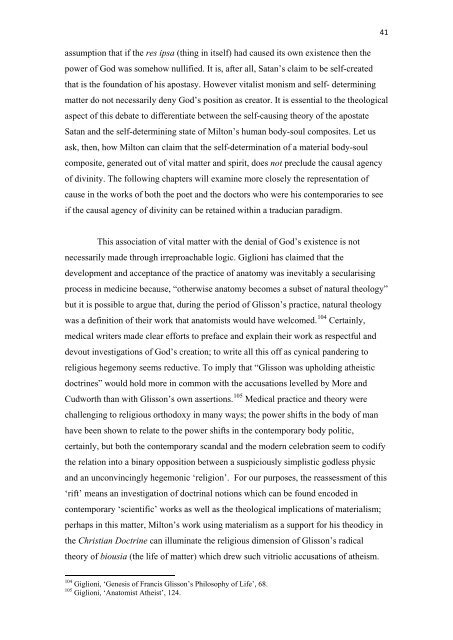Medical Science and the Anatomia Animata in Milton's Paradise Lost
Medical Science and the Anatomia Animata in Milton's Paradise Lost
Medical Science and the Anatomia Animata in Milton's Paradise Lost
Create successful ePaper yourself
Turn your PDF publications into a flip-book with our unique Google optimized e-Paper software.
assumption that if <strong>the</strong> res ipsa (th<strong>in</strong>g <strong>in</strong> itself) had caused its own existence <strong>the</strong>n <strong>the</strong><br />
power of God was somehow nullified. It is, after all, Satan’s claim to be self-created<br />
that is <strong>the</strong> foundation of his apostasy. However vitalist monism <strong>and</strong> self- determ<strong>in</strong><strong>in</strong>g<br />
matter do not necessarily deny God’s position as creator. It is essential to <strong>the</strong> <strong>the</strong>ological<br />
aspect of this debate to differentiate between <strong>the</strong> self-caus<strong>in</strong>g <strong>the</strong>ory of <strong>the</strong> apostate<br />
Satan <strong>and</strong> <strong>the</strong> self-determ<strong>in</strong><strong>in</strong>g state of Milton’s human body-soul composites. Let us<br />
ask, <strong>the</strong>n, how Milton can claim that <strong>the</strong> self-determ<strong>in</strong>ation of a material body-soul<br />
composite, generated out of vital matter <strong>and</strong> spirit, does not preclude <strong>the</strong> causal agency<br />
of div<strong>in</strong>ity. The follow<strong>in</strong>g chapters will exam<strong>in</strong>e more closely <strong>the</strong> representation of<br />
cause <strong>in</strong> <strong>the</strong> works of both <strong>the</strong> poet <strong>and</strong> <strong>the</strong> doctors who were his contemporaries to see<br />
if <strong>the</strong> causal agency of div<strong>in</strong>ity can be reta<strong>in</strong>ed with<strong>in</strong> a traducian paradigm.<br />
This association of vital matter with <strong>the</strong> denial of God’s existence is not<br />
necessarily made through irreproachable logic. Giglioni has claimed that <strong>the</strong><br />
development <strong>and</strong> acceptance of <strong>the</strong> practice of anatomy was <strong>in</strong>evitably a secularis<strong>in</strong>g<br />
process <strong>in</strong> medic<strong>in</strong>e because, “o<strong>the</strong>rwise anatomy becomes a subset of natural <strong>the</strong>ology”<br />
but it is possible to argue that, dur<strong>in</strong>g <strong>the</strong> period of Glisson’s practice, natural <strong>the</strong>ology<br />
was a def<strong>in</strong>ition of <strong>the</strong>ir work that anatomists would have welcomed. 104 Certa<strong>in</strong>ly,<br />
medical writers made clear efforts to preface <strong>and</strong> expla<strong>in</strong> <strong>the</strong>ir work as respectful <strong>and</strong><br />
devout <strong>in</strong>vestigations of God’s creation; to write all this off as cynical p<strong>and</strong>er<strong>in</strong>g to<br />
religious hegemony seems reductive. To imply that “Glisson was uphold<strong>in</strong>g a<strong>the</strong>istic<br />
doctr<strong>in</strong>es” would hold more <strong>in</strong> common with <strong>the</strong> accusations levelled by More <strong>and</strong><br />
Cudworth than with Glisson’s own assertions. 105<br />
<strong>Medical</strong> practice <strong>and</strong> <strong>the</strong>ory were<br />
challeng<strong>in</strong>g to religious orthodoxy <strong>in</strong> many ways; <strong>the</strong> power shifts <strong>in</strong> <strong>the</strong> body of man<br />
have been shown to relate to <strong>the</strong> power shifts <strong>in</strong> <strong>the</strong> contemporary body politic,<br />
certa<strong>in</strong>ly, but both <strong>the</strong> contemporary sc<strong>and</strong>al <strong>and</strong> <strong>the</strong> modern celebration seem to codify<br />
<strong>the</strong> relation <strong>in</strong>to a b<strong>in</strong>ary opposition between a suspiciously simplistic godless physic<br />
<strong>and</strong> an unconv<strong>in</strong>c<strong>in</strong>gly hegemonic ‘religion’. For our purposes, <strong>the</strong> reassessment of this<br />
‘rift’ means an <strong>in</strong>vestigation of doctr<strong>in</strong>al notions which can be found encoded <strong>in</strong><br />
contemporary ‘scientific’ works as well as <strong>the</strong> <strong>the</strong>ological implications of materialism;<br />
perhaps <strong>in</strong> this matter, Milton’s work us<strong>in</strong>g materialism as a support for his <strong>the</strong>odicy <strong>in</strong><br />
<strong>the</strong> Christian Doctr<strong>in</strong>e can illum<strong>in</strong>ate <strong>the</strong> religious dimension of Glisson’s radical<br />
<strong>the</strong>ory of biousia (<strong>the</strong> life of matter) which drew such vitriolic accusations of a<strong>the</strong>ism.<br />
104<br />
Giglioni, ‘Genesis of Francis Glisson’s Philosophy of Life’, 68.<br />
105<br />
Giglioni, ‘Anatomist A<strong>the</strong>ist’, 124.<br />
41
















